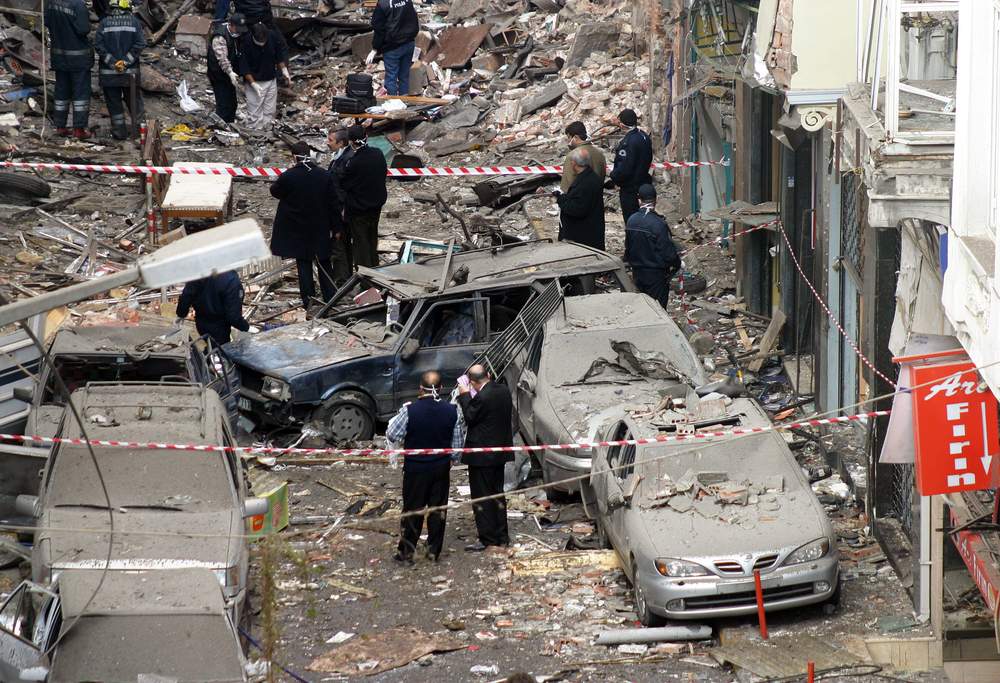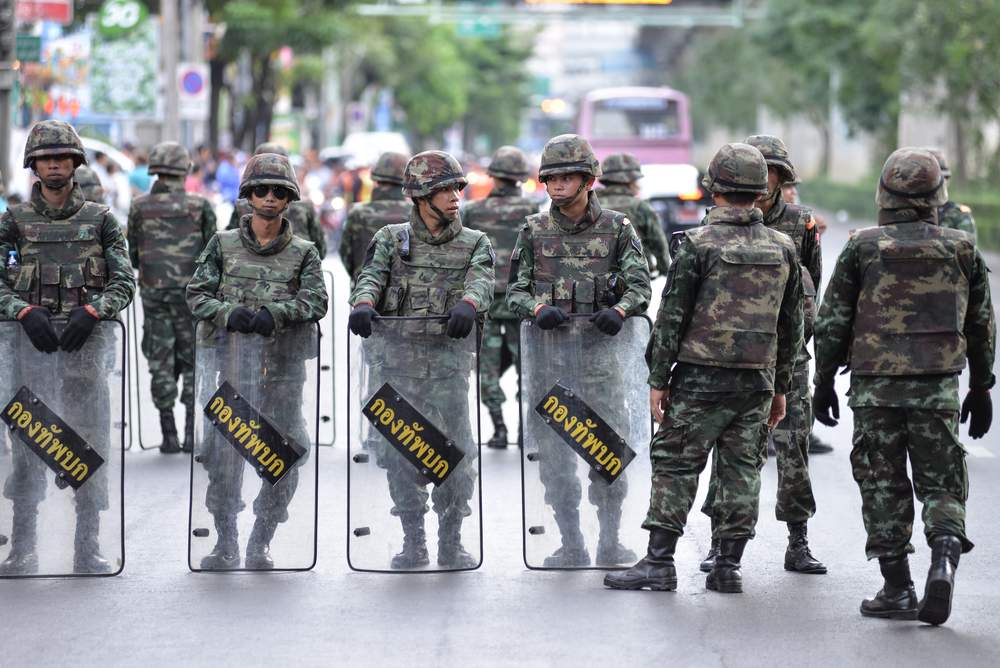Fear is individually unique. One person’s definition of a safe destination can equal another’s worst nightmare. However, regardless of whether you sport a high fear factor or quiver at the sight of your own shadow (I idle somewhere in between), there are certain destinations around the globe that sit at the upper end of the spectrum of
dangerous.
The reasons that turn a spot into a danger zone are wide ranging, from war, to natural disasters, to terrorism, to violent civil unrest.
Whether you’re trying to decide if you should include a potential danger zone on your itinerary or the safety of a location on your route changes mid-trip, these hotspots present problems for long-term travelers. In a world that’s ever changing, the matter of a destination’s safety may crop up more than you think. In a 14 month trip the issue gave me serious pause for thought on at least four occasions:
- The first conundrum came when I was planning my trip. I desperately wanted to cross from South into Central America by land, which meant navigating the Darien Gap, a rather lawless stretch of jungle known for indiscriminate kidnapping, killing, and natural dangers.
- The second instance came just two weeks into my trip when an attempted coup in Ecuador forced the borders shut and grounded all flights before I had the chance to take off from Madrid.
- The third time sadly saw the tsunami hit the northern coast of Japan, which also caused damage to the Fukushima nuclear plant.
- The final occasion (and I’m now wondering if I was actually particularly unfortunate) interfered with my route home, which I had intended to take through the Middle East and many of the countries that were involved in the Arab Spring.
When safety issues do arise, your own sense of risk will make most of the decision for you (though bear in mind that simply because you’re not worried about something bad happening doesn’t make it less likely).
To help with the rest of the decision making and with my own experiences in mind, here are a few tips to help you make an informed choice on whether to visit or steer clear of an unsafe destination.
Check Government Warnings

The foreign office in most country’s will keep a pretty comprehensive list of the relative safety, or otherwise, of every country around the world and is the natural first port of call if you’re looking for information on the danger levels presented by a particular place. These travel advice guides are usually accessible online, updated frequently, and are especially helpful with emerging issues.
“Do keep in mind that the advice can read like they’ve been written by your travel fearing relatives…”
Do keep in mind that the advice can read like they’ve been written by your travel fearing relatives, as they tend to catalogue a country’s every safety breach, so it’s a good idea to read more widely for a broader perspective. It’s also worth checking more than one country’s foreign office website.
Consider Who is Most at Risk
Natural disasters are indiscriminate in selecting victims, as are terrorist attacks that target public transport for maximum devastation, but gang wars and drug fighting rarely have tourists in their sights, and with a low key presence it can be possible to visit even dangerous locations without becoming another statistic on the fatality list. Of course, such a decision shouldn’t be taken lightly, and the fact that tourists aren’t usually on the hit list doesn’t mean there is no risk of getting caught up in the metaphorical (or literal) crossfire, so it definitely pays to take precautions in all high risk locations, but understanding who is most at risk of the danger in question should aid your decision on whether to visit.
Get city specific

Fear can be a bit broad brush with uninformed perceptions categorizing entire countries as safe or unsafe, when in reality an issue that may prevail in one corner does not mean that travel to the entire country should be off the cards. This is particularly true in large countries – for example a hurricane hitting the Caribbean coast of Mexico doesn’t mean there can’t be sunshine on the Pacific side. The London riots of 2011 that quickly spread to other major cities in England, including Birmingham and Manchester, didn’t preclude the possibility of a quaint coastal retreat in rugged Cornwall where cream tea, not looting, was the main item on the agenda.
Are Commercial Flights Active or Suspended?
While it is possible to take a flight to many of the world’s most dangerous places (Air France will happily fly you from New York to Kinchasa, Democratic Republic of Congo with a short stop in
Paris), instances where airlines have grounded flights to a country can be a red flag of trouble you don’t want to go wading into. Airlines are in business to make money, after all, and the decision to stop flights is not usually taken lightly.
The trick is to determine the reason behind flights being ceased. Airline strikes are rarely an indication of danger, and even if civil protests are taking part in a country’s main airport, as happened in Bangkok some time ago, other parts of the country, like the southern Thai islands, can still be safe if reachable without need to go through the danger zone. Flights are also sometimes ground for airline safety purposes. For example, many flights throughout Europe were cancelled during the Icelandic volcanic ash cloud, but that didn’t mean it was unsafe to visit Rome, provided you could get there by other means.
Flights to Quito were temporarily suspended during the coup that affected my trip, but were reopened some time later, meaning I was able to make it to Ecuador after all, but not before a period of brow mopping worry.
Will You be Covered by Your Insurance Company?

Before you undertake any intrepid trave,l it is worth reading the small print in your
insurance documentation. While I may or may not take comfort in the notion that I have coverage for kidnapping ($70 a day apparently, though I’m not sure if that is for me or my captors!) my entire policy is null and void during any period I spend in a location that has been listed as “do not travel” by my government’s foreign office.
“I knew that my insurance was invalid for a 40 minute flight over the mysterious Peruvian Nazca lines, but it was a risk I was personally prepared to take.”
While that doesn’t mean I can’t venture into the Darien Gap (I didn’t, as it turns out, have the nerve to do so), it’s a factor worth weighing up. Without being able to call on the financial clout of your insurance company to come get you out or pick up the tab for any medical emergencies, you truly are on your own if you choose to take the trip. Yet sometimes the risk may seem worth it. I knew that my insurance was invalid for a 40 minute flight over the mysterious Peruvian Nazca lines, but it was a risk I was personally prepared to take, but to make the choice knowing whether you’re covered or not is the important point.
Keep up With the News
The news, both local and international, is one of the best sources for keeping up to date as developments unfold, and it should be checked regularly to understand a location’s safety levels. Do, however, be prepared to take what you read with a grain of salt. For quite a while after I’d landed in Quito many of the online news reports continued to show the dramatic photographs of tanks rolling through the colonial streets when in reality everything had returned to near normal within 48 hours of the attempted coup. Sensational pictures generate more hits and paper purchases, so don’t rely on images alone to provide the most accurate portrayal.
Are the Borders Open?

If a country’s borders are closed, the question of whether to visit is taken out of your hands. However, a little more thought is required if the country in question swings through periods of having its borders open and closed. While it may be tempting to rush in while access is allowed, consider what happens if the borders re-close while you’re in the country. This will present more of a problem if the country in question has borders with only one other country or has a practice of closing all of its borders in the face of danger or dispute. I’ve yet to experience what might happen in such a case if the borders remain closed beyond the validity of your visa. At best, this is likely to be an expensive experience.
What’s the Risk of the Dangerous Instance Recurring?
The pro-democracy disturbances in Egypt and throughout the Middle East have, seemingly, been ongoing for years, and regular demonstrations are still ongoing in many places. Unlike the Ecuadorian attempted coup, the Arab Spring was not a one-off incident that hit and blew over in a matter of hours, and the situation in Egypt right now has many travelers canceling their trips to the country. I ended up not visiting all of the locations on my planned Middle East trip (though they remain firmly on my list for some future date).
The issue in Quito by comparison may have sent tanks and troops to the streets in hoards, making for some pretty scary looking news reports, but in reality the situation was resolved relatively quickly, and there appeared to be little risk in that instance of a repeat performance, contributing to my decision to visit the county. Read the news and check out the country’s history of disputes to make an informed analysis.
How Great is the Risk if There is a Recurrence?

Finding yourself knee high with your pack above your head in the midst of water flooding is unpleasant, but clearly represents a different level of risk compared to widespread and potentially fatal violence. If the country or place you’re planning on visiting has seen recent trouble sufficient to be considered a risky place to visit, it’s worth weighing up the impact of the risk if it does recur. I, unfortunately, didn’t end up taking my trip to Japan following the tsunami. After the initial concerns passed that there would be a secondary tsunami, the situation at the Fukushima nuclear plant was ongoing and uncertain, so it was not something I wanted to face.
Have Other Travelers Been Recently and Survived?
It’s mercenary but true, that one of the best ways to find out if an ATM or power socket close to a puddle of water is working is to let someone use it before you. The same principle can be extended to danger zones. I recently encountered a young college leaver named Tom, from England, who, together with his father, was about to embark on an expedition into the Darien Gap. His father has military training (I’m not sure if this makes me feel more or less confident), and as Tom watched me turn green with traveler, envy it didn’t take long for an invitation to be extended. With a fear reducing cerveza in hand I was momentarily tempted to join them, but the truth is that until the likes of Tom and his father have cut a path, made friends with the locals, and opened a well-worn hostel, I won’t be entering the Darien Gap anytime soon. For now, I’m happy to let other travelers test the safety, and I’ll take my cue from there.
Consider Extra Measures to Reduce Risk
It’s often possible to mitigate safety issues by taking the right precautions, many of which come as standard practice for most indie travelers. Ensuring your immunizations are up to date can protect against diseases, like typhoid, that can increase with natural disasters. Let people know where you’re going to be and when, with as much date and location detail as possible. As well as giving this information to family and friends, notify your consulate (many have the functionality for you to do this online).
“Let people know where you’re going to be and when, with as much date and location detail as possible.”
Have additional copies of your travel documents in case the originals get damaged or taken. Try to find a travel buddy for the safety in numbers principle. Keep an eye on the news and weather, and speak to the locals and other travelers for up to the minute details. If possible, ensure that you have access to emergency funds. Leaving a country at pace in the midst of danger can often come at cost, but it’s an expense you’re unlikely to regret.
Is There a Viable Exit Strategy?

Ok, it’s unlikely your backpacking budget will stretch to a Bond style helicopter to drag you out of a war zone, but planning, and having confidence in, your exit strategy can make the difference if you’re borderline between going to a risky destination or not.
Know the local transport options, length of time to the borders and/or nearest safe zone, and cost of getting there, accepting that costs may increase exponentially with danger (entrepreneurial taxi drivers can read your fear at a hundred paces and will charge accordingly).
Find out what, if any, assistance might be available from your consulate and insurance company, or if you have local friends who can help you plot a route through a sticky situation. Also make sure you’re properly equipped – I’m not talking machetes and hand grenades (though a small penknife has got me out of more than spot of bother in the past) but anything relative to the issue you’re facing, e.g. clothing that is more robust than flip-flops in the face of flash floods and language skills for dealing with potential local conflicts. The point is, the more prepared you are, the better.
Safety is a genuine concern but proper planning and a good measure of common sense sees the vast majority of travelers return home entirely unscathed. Give unsafe destinations due consideration, but do so with perspective – I don’t know the exact number of people who die slipping on banana skins or who suffer fatal blows from falling coconuts, but I’d bet a fair portion of my backpacking budget that the lesser considered dangers are more prevalent than those we spend the most time fretting over.
Check out the following articles to make sure you’re prepared for any problems that may arise during your travels:





